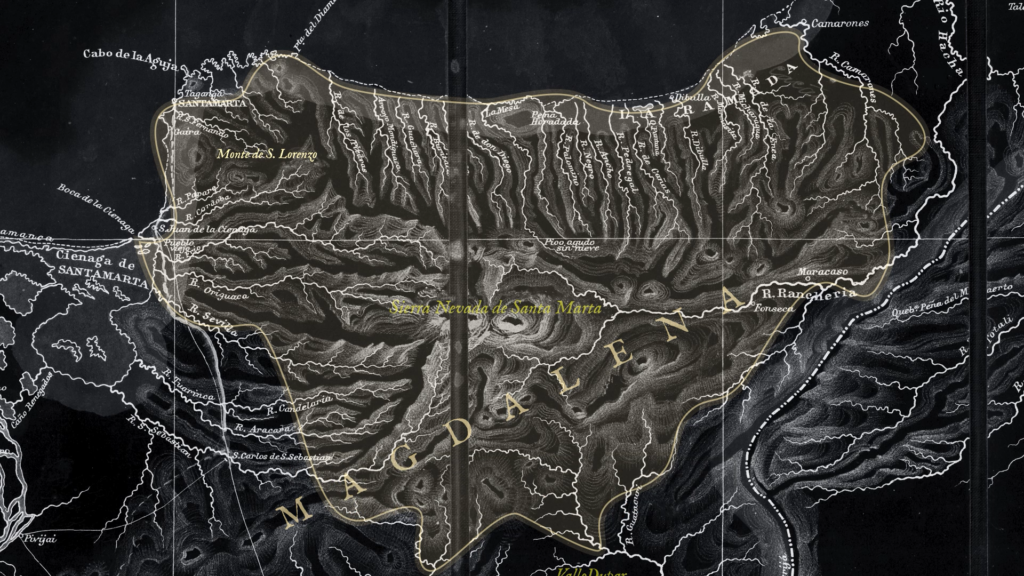Indigenous Groups
The Sierra Nevada is home to four indigenous groups: the Kogui, the Wiwa, the Aruaco and the Kankuamo.
They are the remnants of the Tairona, a sophisticated civilization dating back to 200 BCE. The Tairona had extensive sustainable farming and architecture that included crop rotation, vertical ecology, and terraced draining systems designed to minimize erosion. The Tairona were also particularly skilled in gold work, the latter of which drew unwanted attention from Spanish colonizers who arrived in the early 16th century.
The Spaniards were not only drawn by Tairona gold. They also sought manpower. Conflict, slavery, and exposure to new diseases decreased the Tairona population drastically, and pushed parts of the population further up into the Sierra Nevada mountains to distance themselves from the Spanish. This allowed them to escape the more extreme measures of the colonial system during the 1700s and 1800s, but it also resulted in isolation between communities.
Today, each group has its their own social structures, laws, beliefs, languages. Even so, their shared history is evident. All groups recognize each other as the “Cuatro Pueblos” (Four Peoples) of the Sierra Nevada, the mountain they recognize as their ancestral home. They all place great value on its physical, spiritual, and cosmological importance in the world. They consider it the origin of creation, the center of life and the place where the balance of the world is regulated. This is the reason why Sierra Nevada is sometimes known as “El Corazón del Mundo” (the heart of the world); it is the region that pumps life through the rest of the planet.
Important to each of the indigenous groups of the Sierra Nevada is the idea of balance between the forces and the general importance of the value of the Sierra Nevada extends beyond the spiritual and cosmological into the scientific. It has been a National Park since 1964, a UNESCO Biosphere Reserve since 1979, and is proposed as a World Heritage Site of mixed cultural and natural importance. The highest peak in the Sierra Nevada, Pico Colón, reaches an altitude of 5,775 meters in just 42 km of the Caribbean coast. It is the highest coastal mountain in the world, its fifth most prominent peak, and the highest in Colombia.
This tropical ‘biogeographic island’ has all the thermal floors and has exceptional ecological biodiversity, from tropical beaches to permanently snow-capped peaks. To the west, the Sierra Nevada borders Colombia’s largest river, the Madalena, and the swampy Ciénega Grande, and to the east it dominates the vast Guajira desert. Due to these unique characteristics, Sierra Nevada has a very high level of biodiversity with many endemic species of flora and fauna. Extensive research published in the ‘Science Magazine’ determined that the Sierra Nevada is the world’s most irreplaceable protected area for threatened species.
The Four Peoples state that they have a common way of being and perceiving in Sierra Nevada, guided by a “thought” of collective consciousness of the “Mother” who has entrusted them with the care of the Heart of the World. Geographically, they roughly divide the Sierra Nevada into quadrants: the Kogui in the north and northwest, the Arhuaco in the south and southwest, the Wiwa in the east and northeast, and the Kankuamos in the southeast. They are sometimes thought of as four legs of a table, each separate but essential for balance. Their understanding of the world, their responsibility to the natural world, and treatment of sacred sites are very much aligned. They also share a creation story, seeing themselves as the human descendants of Mother Earth.
Increasingly, the Kogui, Arhuaco, Wiwa and Kankuamo are seeing the need to work together and mobilize politically to defend Sierra Nevada and their societies. Since the 1970s and 1980s, they have taken a more active role on the public stage to actively influence the treatment of their homeland. Their first major victory came with the 1973 legal declaration officially recognizing the linea negra (black line), a chain of sacred sites where offerings or “payments” are made to the natural world and define their territory.

Issues of concern and the reasons for their collective mobilization include the growing number of environmentally damaging practices they view as causing large-scale physical and spiritual deterioration, such as deforestation, damming of rivers, new infrastructure, mining and manipulation of archaeological sites. The stability of the world depends on the stability of the Sierra.
The need to address these environmental and spiritual concerns has pushed the groups to make public appearances, despite a history of survival through isolation. The first great example of this was through the 1990 documentary for the BBC ‘From the Heart of the World’. It starts by saying:
"We take care of nature, and the Mamas see that you are killing it for what you do. We can't fix the world anymore, you must. You are uprooting the Earth, and we are guessing to figure out how to teach you to stop"
Unfortunately, there is also increased tension between the indigenous groups and their younger brothers due to treasure hunters and looters looking for gold and other items. This was exacerbated by the discovery of the lost city. The ensuing years have brought a wide range of different interests to the region, interests that clash with native traditions and beliefs. Mass production of marijuana and later coca fields on the lower slopes attracting different armed guerilla groups and paramilitaries all had incentives to appropriate their territory and sacred sites. Now, the threats to the indigenous way of life and spiritual beliefs have changed, but they have not disappeared. Development, construction, and tourism continue to have strong impacts on the people of the Sierra Nevada, which they are trying to navigate.
